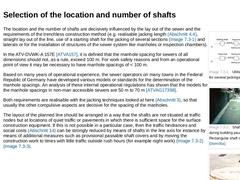
|
|
(Image: Utilisation of a shaft for several jackings [Stein05a])
|
|
(Image: Shaft coverings during building pauses - Rectangular shaft covering [Stein05a])
|
|
(Image: Shaft coverings during building pauses - Circular shaft covering [FI-KCMM])
|
The location and the number of shafts are decisively influenced by the lay out of the sewer and the requirements of the trenchless construction method (e.g. realisable jacking length (Abschnitt 4.4), straight … |
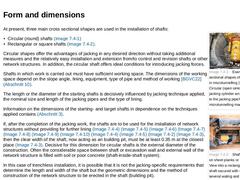
|
|
(Image: Examples of cross sectional shapes of starting shafts in microtunnelling [FI-Herreb] - Circular (open sinking shaft), jacking cylinder arranged parallel to the jacking pipe/to the microtunnelling machine)
|
|
(Image: Shaft support based on sheet planks or sheet piles - View into a rectangular starting shaft secured with sheet piles and several waling and brace layers (jacking pipe arranged in front of the pressure ring) [FI-Herreb])
|
|
(Image: … |
|
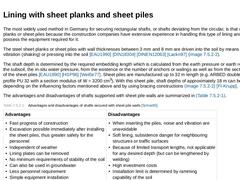
|
The most widely used method in Germany for securing rectangular shafts, or shafts deviating from the circular, is that of using sheet planks or sheet piles because the construction companies have extensive experience in handling this type of lining and usually also possess the equipment required for it. The steel sheet planks or sheet piles with wall thicknesses between 3 mm and 8 mm are driven into the soil by means of ramming, vibration (shaking) … |
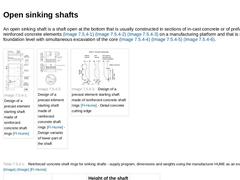
|
An open sinking shaft is a shaft open at the bottom that is usually constructed in sections of in-cast concrete or of prefabricated reinforced concrete elements (Bild 6.4.3) (Bild 6.4.3) (Bild 6.4.3) on a manufacturing platform and that is sunk to its foundation level with simultaneous excavation of the core (Bild 3) (Bild 3) (Bild 3). | (Image: Design of a precast element starting shaft made of reinforced concrete shaft rings [FI-Hume]) |
(Image: Design … |
|

|
(Image: Methods for securing shafts [Stein05a]) Decisive for the selection of a method of shaft construction, i.e. the measures for sinking and securing of a shaft, can be, for example [Stein05a] : - Dimensions (length, width and depth of the shaft)
- Selected jacking method
- Geological and hydrogeological conditions
- Local conditions (e.g. available space, surface utilization, traffic loads)
- Environmental protection (limiting values of emissions during …
|
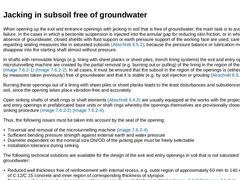
|
When opening up the exit and entrance openings with jacking in soil that is free of groundwater, the main task is to avoid ground failure. In the cases in which a bentonite suspension is injected into the annular gap for reducing skin friction, or in which, despite the absence of groundwater, closed shields with fluid support or earth pressure support of the working face are used, care must be taken regarding sealing measures like in saturated subsoils (… |
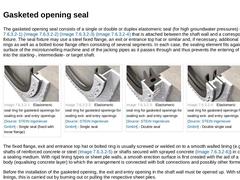
|
The gasketed opening seal consists of a single or double or duplex elastomeric seal (for high groundwater pressures) (Bild 6.5.2.1) (Bild 6.5.2.1) (Bild 6.5.2.1) (Bild 6.5.2.1) that is attached between the shaft wall and a correspondingly seal fixture. The seal fixture may use a steel fixed flange, an exit or entrance top hat or similar and, if necessary, additional intermediate rings as well as a bolted loose flange often consisting of several segments. … |
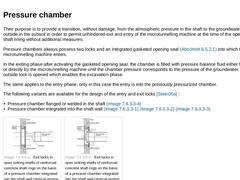
|
Their purpose is to provide a transition, without damage, from the atmospheric pressure in the shaft to the groundwater pressure outside in the subsoil in order to permit unhindered exit and entry of the microtunnelling machine at the time of the opening of the shaft lining without additional measures. Pressure chambers always possess two locks and an integrated gasketed opening seal (Abschnitt 6.5.2.1) into which the microtunnelling machine enters. |
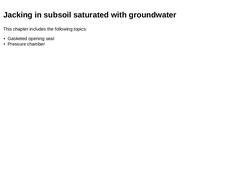
|
(Image: Dewatering properties of different types of soils with water retention measures [Herth95]) The following measures are possible in order to prevent ground failure and groundwater inflows when creating and traversing the exit and entry openings [Stein05a] : - Open water retention
- Groundwater lowering
- Groundwater cut-off
The simplest solutions, when technically possible are water retention measures for lowering the groundwater level [Rappe96] [DIN18305]. |

|
Within the scope of microtunnelling and pilot pipe jacking a difference is made between the following phases of jacking [Konra01] : - Exiting (starting)
Exiting is the phase of jacking from the beginning of opening the lining or the start of the approach of the boring head to the in-situ subsoil up to the completion of all special measures. The sequence of the activities can be repeated when traversing an intermediate shaft.
- Excavation
Excavation is the …
|
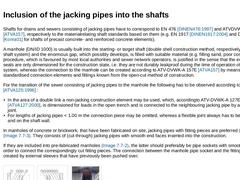
|
Shafts for drains and sewers consisting of jacking pipes have to correspond to EN 476 [DINEN476:1997] and ATVDVWK A 157E [ATVA157], respectively to the materialrelating shaft standards based on them (e.g. EN 1917 [DINEN1917:2004] and DIN V 4034-1 [Konra01] for shafts of precast concrete- and reinforced concrete elements). A manhole (DN/ID 1000) is usually built into the starting- or target shaft (double shell construction method, respectively shaft-… |
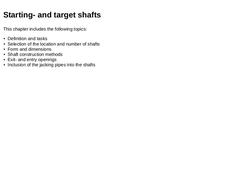
|
|
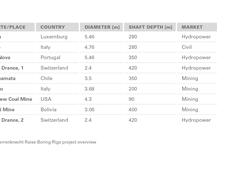
|
Jun 16, 2014
Article
Herrenknecht AG
With growing demand for raw materials, mines are applying increasing effort and expense to open up deep and difficult to access resources. With this in mind, the new Herrenknecht product portfolio of Raise Boring Rigs allows the optimal drilling of shafts with larger diametersat depths of up to 2,000 meters.
In the new and further development of Raise Boring Rigs, Herrenknecht draws on proven technologies and components as well as on extensive knowhow in the area of mechanized tunnelling technology.
|
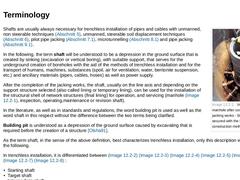
|
(Image: Installation of a manhole after completion of the jacking works - Starting shaft secured with the spray concrete construction method [Köln91]) Shafts are usually always necessary for trenchless installation of pipes and cables with unmanned, non steerable techniques (Abschnitt 5), unmanned, steerable soil displacement techniques (Abschnitt 6), pilot pipe jacking (Abschnitt 7.1), microtunnelling (Abschnitt 8.1) and pipe jacking (Abschnitt 9.1). |
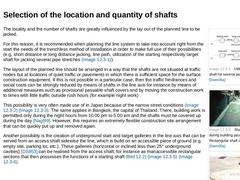
|
| (Image: Utilisation of a shaft for several jackings [Stein05a]) | | (Image: Shaft coverings during building pauses - Rectangular shaft covering [Stein05a]) | | (Image: Shaft coverings during building pauses - Circular shaft covering [FI-KCMM]) |
The locality and the number of shafts are greatly influenced by the lay out of the planned line to be jacked. For this reason, it is recommended when planning the line system to take into account right from the start … |
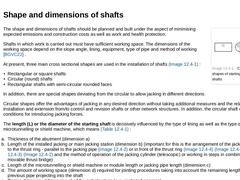
|
(Image: Cross sectional shapes of starting and target shafts) The shape and dimensions of shafts should be planned and built under the aspect of minimising expected emissions and construction costs as well as work and health protection. Shafts in which work is carried out must have sufficient working space. The dimensions of the working space depend on the slope angle, lining, equipment, type of pipe and method of working [BGVC22] . At present, three … |
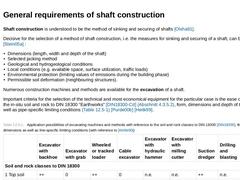
|
Shaft construction is understood to be the method of sinking and securing of shafts [Olsha91]. Decisive for the selection of a method of shaft construction, i.e. the measures for sinking and securing of a shaft, can be, for example [Stein05a] : - Dimensions (length, width and depth of the shaft)
- Selected jacking method
- Geological and hydrogeological conditions
- Local conditions (e.g. available space, surface utilization, traffic loads)
- Environmental protection (…
|
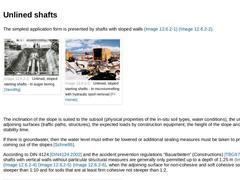
|
The simplest application form is presented by shafts with sloped walls (Bild 12.5.1) (Bild 12.5.1). | (Image: Unlined, sloped starting shafts - In auger boring [Stein89g]) |
(Image: Unlined, sloped starting shafts - In microtunnelling with hydraulic spoil removal [FI-Herreb]) |
The inclination of the slope is suited to the subsoil (physical properties of the in-situ soil types, water conditions), the utilization of the adjoining surfaces (traffic paths, … |
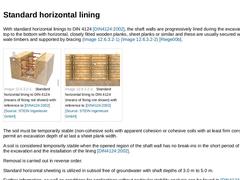
|
With standard horizontal linings to DIN 4124 [DIN4124:2002], the shaft walls are progressively lined during the excavation from the top to the bottom with horizontal, closely fitted wooden planks, sheet planks or similar and these are usually secured with vertical wale timbers and supported by bracing (Bild 12.5.2.1) (Bild 12.5.2.1) [Riege00b]. |
(Image: Standard horizontal lining to DIN 4124 (means of fixing not shown) with reference to [DIN4124c] [… |
|
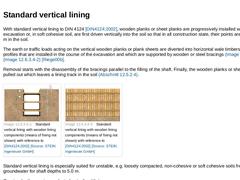
|
With standard vertical lining to DIN 4124 [DIN4124:2002], wooden planks or sheet planks are progressively installed with the excavation or, in soft cohesive soil, are first driven vertically into the soil so that in all construction state, their points are at least 0.30 m in the soil. The earth or traffic loads acting on the vertical wooden planks or plank sheets are diverted into horizontal wale timbers or steel profiles that are installed in the … |
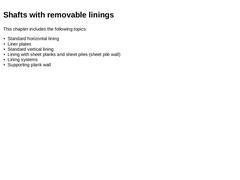
|
|
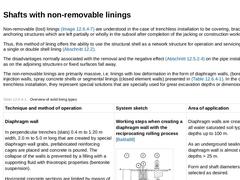
|
Non-removable (lost) linings (Bild 12.4) are understood in the case of trenchless installation to be covering, bracing and anchoring structures which are left partially or wholly in the subsoil after completion of the jacking or construction works. Thus, this method of lining offers the ability to use the structural shell as a network structure for operation and servicing in the form of a single or double shell lining (Abschnitt 12.2). The disadvantages … |
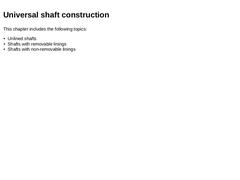
|
|
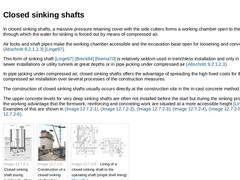
|
In closed sinking shafts, a massive pressure retaining cover with the side cutters forms a working chamber open to the bottom through which the water for sinking is forced out by means of compressed air. Air locks and shaft pipes make the working chamber accessible and the excavation base open for loosening and conveying the soil (Abschnitt 9.2.1.2.3) [Linge97]. This form of sinking shaft [Linge97] [Breck84] [Niema70] is relatively seldom used in trenchless … |
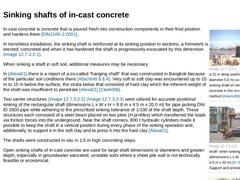
|
|
(Image: Construction of a 22 m deep starting shaft (inside diameter 5.0 m) as an open sinking shaft of reinforced concrete in the in-cast concreting method [Adams99])
|
|
(Image: "Hanging shaft" when sinking in soft soil (dimensions L x W x H = 8.8 m x 4.5 m x 20 m) [FI-Skansa] - Support and pressing construction)
|
|
(Image: "Hanging shaft" when sinking in soft soil (dimensions L x W x H = 8.8 m x 4.5 m x 20 m) [FI-Skansa] - View into the completed … |
|